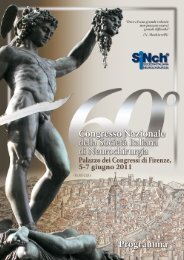Scarica il programma completo in pdf - Denis Vitali
Scarica il programma completo in pdf - Denis Vitali
Scarica il programma completo in pdf - Denis Vitali
Create successful ePaper yourself
Turn your PDF publications into a flip-book with our unique Google optimized e-Paper software.
PROGRAMMA SOCIALE<br />
SOCIAL PROGRAMME<br />
VISITA GUIDATA<br />
Giovedì 6 novembre 2008<br />
Aqu<strong>il</strong>eia<br />
Fondata dai romani nel 181 a.C. sulla riva destra del<br />
fiume Natisone-Torre, Aqu<strong>il</strong>eia divenne la base per<br />
la difesa del territorio e l'espansione romana verso<br />
nord-est. All'epoca di Augusto fu capitale della Venetia<br />
et Histria e una delle città più importanti dell'Impero.<br />
Il commercio fiorì grazie al grande porto<br />
fluviale e a una vasta rete stradale. Oggi <strong>il</strong> Museo Archeologico<br />
conserva testimonianze preziose provenienti<br />
dagli scavi della città, che ne documentano<br />
l'elevato livello d'arte e di cultura. Notevoli tra le altre<br />
cose sono la raccolta di gemme e quella di manufatti<br />
<strong>in</strong> vetro soffiato. Luogo di <strong>in</strong>contro e di mediazione<br />
tra l'Oriente e l'Italia, Aqu<strong>il</strong>eia vide l'entrata del Cristianesimo<br />
nel III secolo. Il più importante documento<br />
del tempo è la Bas<strong>il</strong>ica Patriarcale, fondata agli<br />
<strong>in</strong>izi del IV secolo. Dell'età di Costant<strong>in</strong>o, fase paleocristiana,<br />
<strong>il</strong> complesso bas<strong>il</strong>icale conserva <strong>il</strong> mosaico<br />
pavimentale che porta <strong>in</strong>tatta tutta la bellezza della<br />
ricca figurazione orig<strong>in</strong>aria. Inf<strong>in</strong>e <strong>il</strong> Museo Paleocristiano<br />
<strong>in</strong> località Monastero conserva preziose raccolte<br />
di iscrizioni figurate e mosaici che risalgono a tale<br />
epoca. Con la distruzione di Aqu<strong>il</strong>eia operata da Att<strong>il</strong>a,<br />
la popolazione del territorio troverà rifugio a<br />
Grado, che da Gradus, antico scalo marittimo, diventerà<br />
Castrum e ne custo Aqu<strong>il</strong>eia.<br />
GUIDED TOUR<br />
THURSDAY, NOVEMBER, 6th 2008<br />
Aqu<strong>il</strong>eia<br />
Founded by the Romans <strong>in</strong> 181 B.C. on the right<br />
bank of the river Natisone-Torre, Aqu<strong>il</strong>eia became a<br />
stronghold for the defence of the territory and for<br />
Roman expansion to the North-East. At the time of<br />
Augustus, it was the capital of Venetia et Histria and<br />
one of the most important cities <strong>in</strong> the Empire. Commerce<br />
flourished thanks to the river port and the large<br />
road network. The Archaeological Museum today<br />
conta<strong>in</strong>s the precious evidence of the city excavations,<br />
show<strong>in</strong>g the very high artistic and cultural development<br />
reached by the city. Particularly noteworthy<br />
among the other th<strong>in</strong>gs are the collections of gems<br />
and blown glass objects. A meet<strong>in</strong>g place between the<br />
East and Italy, Aqu<strong>il</strong>eia witnessed the arrival of Christianity<br />
<strong>in</strong> the 3rd century. The most important historical<br />
document of the time is the Bas<strong>il</strong>ica<br />
Patriarcale, founded <strong>in</strong> the early 4th century. S<strong>in</strong>ce<br />
the age of Constant<strong>in</strong>e, <strong>in</strong> the Paleochristian period,<br />
the bas<strong>il</strong>ica complex has reta<strong>in</strong>ed the floor mosaic<br />
with the <strong>in</strong>tact beauty of the rich, orig<strong>in</strong>al figure patterns.<br />
F<strong>in</strong>ally, the Museo Paleocristiano <strong>in</strong> Monastero<br />
conta<strong>in</strong>s the precious collections of figurative <strong>in</strong>scriptions<br />
and mosaics dat<strong>in</strong>g back to this period. After the<br />
destruction of Aqu<strong>il</strong>eia by Att<strong>il</strong>a, the local population<br />
found shelter <strong>in</strong> Grado, the old Gradus, an ancient<br />
sea port that w<strong>il</strong>l later become Castrum and keep its<br />
culture alive for the follow<strong>in</strong>g two centuries.<br />
Castello di Du<strong>in</strong>o<br />
The Castle of Du<strong>in</strong>o<br />
Informazioni Generali General Information<br />
75




